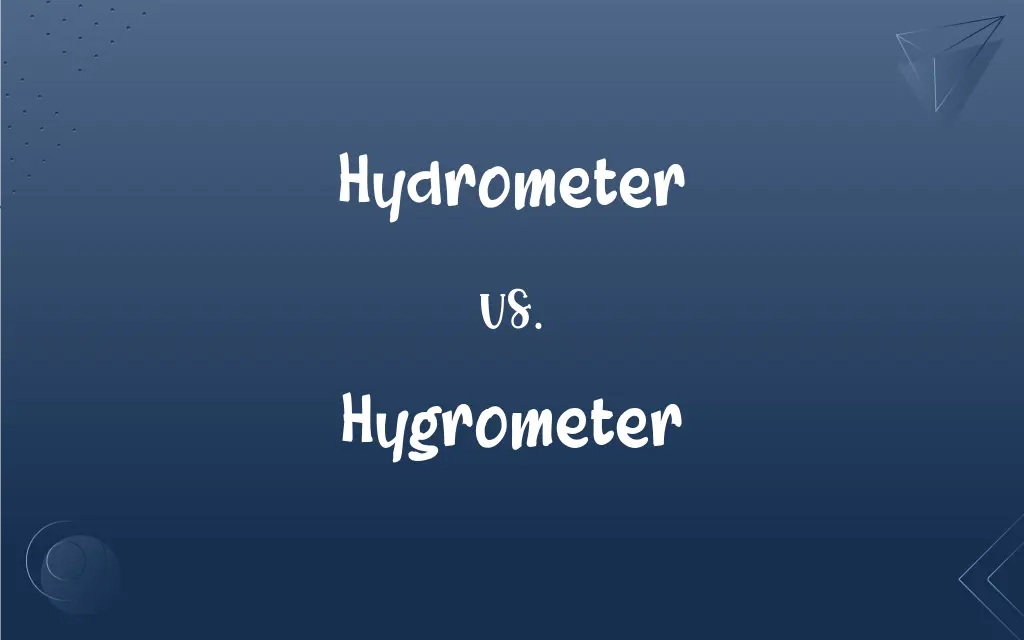Hydrometer vs. Hygrometer: What's the Difference?
Edited by Aimie Carlson || By Harlon Moss || Updated on October 20, 2023
A hydrometer measures liquid density, while a hygrometer measures humidity levels.

Key Differences
A hydrometer is an instrument designed to measure the specific gravity (or relative density) of liquids. This is essentially the ratio of the density of the liquid to the density of a reference liquid, often water. By understanding the density of a liquid, users can infer other properties of the liquid, such as its sugar content or alcohol concentration. On the other hand, a hygrometer is a tool used to measure the amount of humidity present in the air. Humidity is the concentration of water vapor in the atmosphere.
The use of a hydrometer can be seen in various industries. For instance, in brewing and winemaking, it helps in determining the alcohol content of the finished product. In contrast, a hygrometer is invaluable in meteorology, helping to predict weather conditions. A hygrometer can indicate the likelihood of precipitation, dew, or frost.
Both hydrometers and hygrometers have crucial roles in their respective applications. Hydrometers, for example, can be pivotal in ensuring the quality and consistency of beverages in the production phase. Meanwhile, hygrometers are essential for homeowners in monitoring indoor air quality and for ensuring that conditions remain conducive for health and comfort.
Though both instruments deal with water in some form, they serve vastly different purposes. A hydrometer's primary role is in determining the characteristics of liquids based on their density. In contrast, a hygrometer's main function revolves around assessing atmospheric conditions, particularly humidity levels.
Comparison Chart
Function
Measures liquid density.
Measures humidity levels.
ADVERTISEMENT
Common Usage
Brewing, winemaking.
Meteorology, household monitoring.
Measurement
Specific gravity or relative density.
Percentage of humidity.
Interaction Medium
Liquid.
Air.
Principle
Displacement in liquid.
Water vapor concentration.
Hydrometer and Hygrometer Definitions
Hydrometer
A device indicating the relative density of a liquid compared to water.
To ascertain the salt concentration, he submerged the hydrometer in the solution.
ADVERTISEMENT
Hygrometer
A gauge to assist in maintaining optimal humidity conditions indoors.
For his rare book collection, he relied on a hygrometer to monitor moisture levels.
Hydrometer
A tool that determines the specific gravity of a substance.
With a hydrometer, the chemist could deduce the purity of the sample.
Hygrometer
An apparatus that quantifies water vapor concentration in the environment.
The greenhouse had a hygrometer to ensure plants had the right humidity conditions.
Hydrometer
An instrument for measuring the density of liquids.
The brewer used a hydrometer to check the beer's sugar content.
Hygrometer
An instrument to measure atmospheric humidity levels.
Using a hygrometer, she found the room to be excessively humid.
Hydrometer
An apparatus used in industries to check alcohol or sugar concentration.
Winemakers rely on the hydrometer to ensure consistent wine production.
Hygrometer
A device that indicates the amount of moisture in the air.
The hygrometer's reading confirmed the need for a dehumidifier.
Hydrometer
A gauge that floats in a liquid to represent its density.
The hydrometer's position in the tube revealed the liquid's relative density.
Hygrometer
A tool used in meteorology to predict weather conditions based on humidity.
Weather stations utilize hygrometers to provide accurate forecasts.
Hydrometer
An instrument used to determine specific gravity, especially a sealed, graduated tube, weighted at one end, that sinks in a fluid to a depth used as a measure of the fluid's specific gravity.
Hygrometer
Any of several instruments that measure atmospheric humidity.
Hydrometer
An instrument that floats in a liquid and measures its specific gravity on a scale.
Hygrometer
(meteorology) An instrument that measures the humidity of the air or other gases, especially the relative humidity.
Hydrometer
An instrument for determining the specific gravities of liquids, and thence the strength spirituous liquors, saline solutions, etc.
Hygrometer
An instrument for measuring the degree of moisture of the atmosphere.
Hydrometer
An instrument, variously constructed, used for measuring the velocity or discharge of water, as in rivers, from reservoirs, etc., and called by various specific names according to its construction or use, as tachometer, rheometer, hydrometer, pendulum, etc.; a current gauge.
Hygrometer
Measuring instrument for measuring the relative humidity of the atmosphere
Hydrometer
A measuring instrument for determining the specific gravity of a liquid or solid
FAQs
Can a hydrometer measure humidity?
No, a hydrometer measures liquid density, not humidity.
Is a hygrometer useful for home use?
Yes, a hygrometer can help monitor indoor humidity levels for comfort and health.
How does a hygrometer function?
A hygrometer measures the amount of humidity or moisture in the air.
How does a hydrometer determine alcohol content?
By measuring the specific gravity before and after fermentation, allowing for alcohol estimation.
How do electronic hygrometers work?
They often use sensors that measure changes in electrical resistance or capacitance due to humidity.
Can both hydrometers and hygrometers measure the density of liquids?
No, only hydrometers measure liquid density. Hygrometers measure air humidity.
How is a hydrometer different from a thermometer?
A hydrometer measures liquid density, while a thermometer measures temperature.
Can a hygrometer be used to predict frost?
Yes, if humidity levels are high and temperatures drop, it indicates a likelihood of frost.
What is a hydrometer used for?
A hydrometer is used to measure the density or specific gravity of liquids.
What is a typical unit for a hygrometer's reading?
Percentage (%), indicating relative humidity.
How do hygrometers affect HVAC systems?
HVAC systems often use hygrometers to regulate humidity for optimized indoor comfort.
What kind of liquid can a hydrometer measure?
Hydrometers can measure any liquid, from water to alcohol to oil, depending on their calibration.
Why would someone need a hygrometer in a greenhouse?
To monitor and control humidity levels, ensuring optimal plant growth conditions.
Is it essential to calibrate a hygrometer?
Yes, for accurate readings, periodic calibration of a hygrometer is advisable.
What happens if a hydrometer is placed in the air?
A hydrometer won't provide meaningful measurements in air; it's designed for liquids.
Can a hydrometer be used to measure the density of gases?
No, hydrometers are designed specifically for liquids.
Where is the best place to store a hydrometer?
In a safe, upright position, free from extreme temperatures or potential damage.
Is the hydrometer used in the petroleum industry?
Yes, it's used to determine the density of oils and fuels.
Can a hygrometer detect rain?
A hygrometer measures humidity, which can indicate the likelihood of rain but doesn't directly detect it.
What role does a hygrometer play in health?
It helps ensure optimal humidity levels, reducing allergens and respiratory issues.
About Author
Written by
Harlon MossHarlon is a seasoned quality moderator and accomplished content writer for Difference Wiki. An alumnus of the prestigious University of California, he earned his degree in Computer Science. Leveraging his academic background, Harlon brings a meticulous and informed perspective to his work, ensuring content accuracy and excellence.
Edited by
Aimie CarlsonAimie Carlson, holding a master's degree in English literature, is a fervent English language enthusiast. She lends her writing talents to Difference Wiki, a prominent website that specializes in comparisons, offering readers insightful analyses that both captivate and inform.






























































